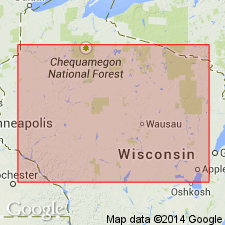
- Usage in publication:
-
- Pokegama Creek Member
- Modifications:
-
- Principal reference
- Dominant lithology:
-
- Till
- Sand
- Silt
- Clay
- AAPG geologic province:
-
- Wisconsin arch
Summary:
Pg. vi (chart), 28-31. Pokegama Creek Member of Copper Falls Formation. Formal definition. (Follows informal usage of M.D. Johnson, 1986, Wisconsin Geol. Nat. Hist. Survey Inf. Circ., no. 55, 42 p., and M.D. Johnson, 1984, Univ. Wisconsin PhD dissert.)
Till. Yellowish red to dark brown, slightly gravelly to gravelly sandy loam, and in part, loamy sand. Thickness up to 7 m. Underlies a few cm of loess. Overlies gravelly sand of Copper Falls Formation, as at type section, or Barron Quartzite, or Cambrian sandstone. Most similar to younger Mikana Member (new) of Copper Falls Formation, but contains more quartzite. Interpreted as having been deposited by southward-flowing ice during early Chippewa advance of Chippewa Lobe, possibly 25,000 to 15,000 yr B.P. (Pleistocene; Wisconsinan).
Type section: Gravel pit, in NW/4 NE/4 SW/4 sec. 1, T. 34 N., R. 11 W., [approx. Lat. 45 deg. 27 min. 28 sec. N., Long. 91 deg. 40 min. 40 sec. W.], Rice Lake South 7.5-min quadrangle, Barron Co., northwestern WI.
Named from Pokegama Creek, whose headwaters are in Blue Hills [northeast of type section]; name credited to Mark D. Johnson.
Reference section: gravel pit, in SW/4 SE/4 SW/4 sec. 1, T. 35 N., R. 10 W., [approx. Lat. 45 deg. 32 min. 16 sec. N., Long. 91 deg. 33 min. 40 sec. W.], Mikana 7.5-min quadrangle, Barron Co., northwestern WI.
[Additional locality information from USGS historical topographic map collection TopoView, accessed on June 9, 2018.]
Source: Publication.
For more information, please contact Nancy Stamm, Geologic Names Committee Secretary.
Asterisk (*) indicates published by U.S. Geological Survey authors.
"No current usage" (†) implies that a name has been abandoned or has fallen into disuse. Former usage and, if known, replacement name given in parentheses ( ).
Slash (/) indicates name conflicts with nomenclatural guidelines (CSN, 1933; ACSN, 1961, 1970; NACSN, 1983, 2005, 2021). May be explained within brackets ([ ]).

